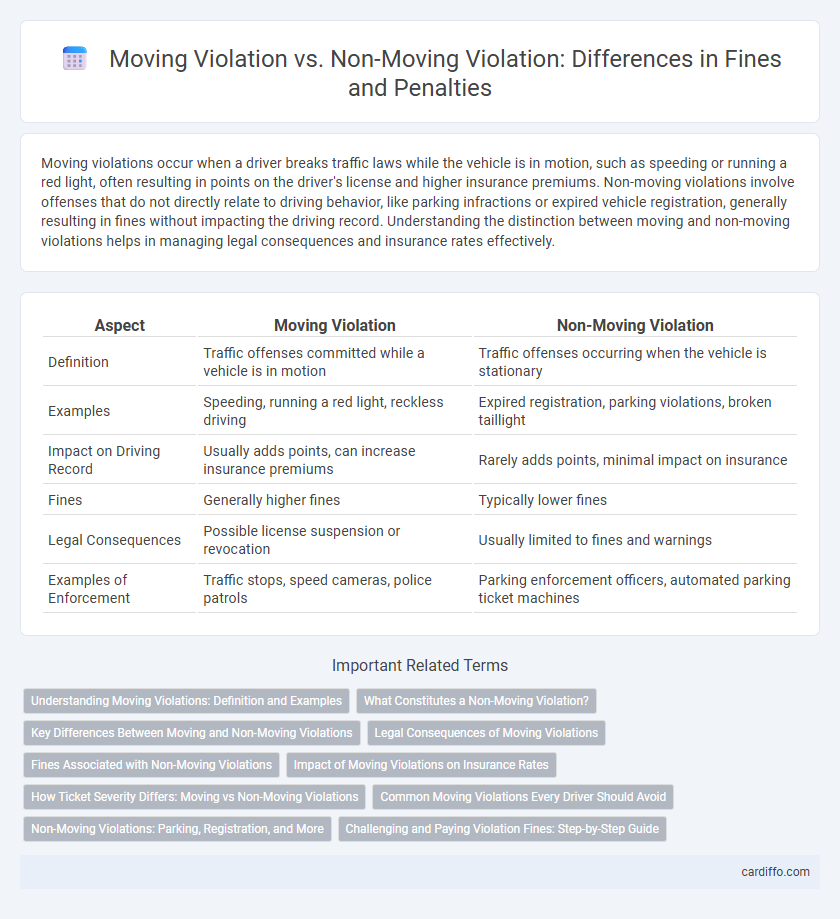Moving violations occur when a driver breaks traffic laws while the vehicle is in motion, such as speeding or running a red light, often resulting in points on the driver's license and higher insurance premiums. Non-moving violations involve offenses that do not directly relate to driving behavior, like parking infractions or expired vehicle registration, generally resulting in fines without impacting the driving record. Understanding the distinction between moving and non-moving violations helps in managing legal consequences and insurance rates effectively.
Table of Comparison
| Aspect | Moving Violation | Non-Moving Violation |
|---|---|---|
| Definition | Traffic offenses committed while a vehicle is in motion | Traffic offenses occurring when the vehicle is stationary |
| Examples | Speeding, running a red light, reckless driving | Expired registration, parking violations, broken taillight |
| Impact on Driving Record | Usually adds points, can increase insurance premiums | Rarely adds points, minimal impact on insurance |
| Fines | Generally higher fines | Typically lower fines |
| Legal Consequences | Possible license suspension or revocation | Usually limited to fines and warnings |
| Examples of Enforcement | Traffic stops, speed cameras, police patrols | Parking enforcement officers, automated parking ticket machines |
Understanding Moving Violations: Definition and Examples
Moving violations are traffic offenses committed while a vehicle is in motion, such as speeding, running a red light, and reckless driving. These infractions often result in points on a driver's license, fines, and potential increases in insurance premiums. Understanding the distinction between moving violations and non-moving violations, like parking tickets, helps drivers recognize the severity and potential legal consequences of their actions on the road.
What Constitutes a Non-Moving Violation?
A non-moving violation refers to infractions that occur without the vehicle being in motion, such as parking violations, expired registration, or equipment defects like broken taillights. These offenses typically result in fines rather than points on a driver's license and do not affect driving records as severely as moving violations. Understanding the distinction is crucial for addressing penalties and avoiding unnecessary license suspensions.
Key Differences Between Moving and Non-Moving Violations
Moving violations involve illegal actions committed while the vehicle is in motion, such as speeding, running red lights, or reckless driving, and they typically result in points on a driver's license and increased insurance premiums. Non-moving violations refer to offenses unrelated to driving behavior, like parking infractions, equipment violations, or expired registration, usually punishable by fines without license points. The key difference lies in the impact on driving records and insurance rates, with moving violations posing greater legal and financial consequences than non-moving ones.
Legal Consequences of Moving Violations
Moving violations result in more severe legal consequences including points on the driver's license, increased insurance premiums, and potential license suspension or revocation. Courts may impose fines, mandatory driving courses, or even jail time for serious offenses like DUI or reckless driving. Non-moving violations typically involve parking or equipment infractions that incur fines without affecting driving privileges.
Fines Associated with Non-Moving Violations
Fines associated with non-moving violations typically vary by jurisdiction but are generally less severe than those for moving violations, often ranging from $50 to $200. Common examples include parking violations, expired vehicle registration, or equipment defects like broken taillights. While non-moving violation fines may be lower, repeated offenses can lead to increased penalties and additional fees.
Impact of Moving Violations on Insurance Rates
Moving violations, such as speeding or running a red light, significantly increase insurance rates due to their direct correlation with accident risk and driving behavior. Insurance companies use moving violations as key data points to assess risk level, often resulting in higher premiums and potential policy cancellations. Non-moving violations, like parking tickets, do not typically affect insurance rates since they do not indicate reckless or unsafe driving habits.
How Ticket Severity Differs: Moving vs Non-Moving Violations
Moving violations involve actions directly related to the operation of a vehicle, such as speeding or running a red light, and typically result in higher fines and points on the driver's license, reflecting their greater impact on road safety. Non-moving violations, including parking infractions or equipment violations, generally incur lower penalties and do not affect driving records since they pose less risk to traffic flow and safety. The severity in ticket consequences is primarily driven by the increased danger and potential for accidents linked to moving violations.
Common Moving Violations Every Driver Should Avoid
Common moving violations every driver should avoid include speeding, running red lights, and reckless driving, as these offenses directly impact road safety and can result in severe penalties. Tailgating, illegal lane changes, and distracted driving also rank among frequent moving violations that increase accident risks. Understanding the consequences of these infractions is crucial for maintaining a clean driving record and ensuring public safety.
Non-Moving Violations: Parking, Registration, and More
Non-moving violations include offenses related to parking infractions, expired vehicle registrations, and equipment defects such as broken tail lights or malfunctioning signals. These infractions do not involve the operation of the vehicle while in motion but can result in fines, points on a driving record, or vehicle impoundment. Understanding the distinctions between non-moving violations and moving violations is essential for managing traffic penalties and maintaining a clear driving history.
Challenging and Paying Violation Fines: Step-by-Step Guide
Challenging a moving violation typically requires gathering evidence such as traffic camera footage, witness statements, and inspection reports, then submitting a formal dispute to the traffic court or administrative agency within the specified deadline. Paying violation fines for non-moving violations, like parking tickets, usually involves online payment portals or mail-in options, with careful attention to deadlines to avoid additional penalties or late fees. Both processes demand thorough understanding of local traffic laws, accurate documentation, and adherence to procedural requirements to ensure either a successful contestation or timely fine settlement.
Moving violation vs non-moving violation Infographic

 cardiffo.com
cardiffo.com